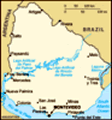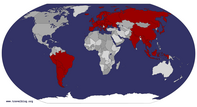Advertisement
The awesome impact of a plane landscape can be vastly underrated. People seek out mountains and valleys; majesty and splendour, but as the saying goes, sometimes you fail to see the forest for the trees. An early morning taxi and boat ride later and we found ourselves no longer in Buenos Aires but in Uruguay, an oft overlooked and predominantly rural country sandwiched between Brazil and Argentina. From the port in Colonia del Sacramento, we were careful to avoid any sight of the old town itself, preferring to leave that as a surprise for our eventual return to this little Portuguese settlement a few days later. Instead, we jumped aboard the first bus we could find headed for Montevideo, the capital city, where we would spend the following three nights. Our ride would only take just over two hours, but like our journey from Asuncion to Encarnacion in Paraguay, we found the Uruguayan countryside to be absolutely stunning. The landscapes were devoid of snow capped peaks or any landmarks worthy of note, but its pastures displayed much of Uruguay’s gaucho culture in the ranging haciendas just the other side our window.
It has already become apparent to us
that the experience of this continent, one which we are enjoying immensely, could be enhanced for those with their own mode of transportation and a tent; those who could simply stop when and where they wished to, turn left instead of right with little or no thought about such a decision and have little need for much of a plan, a realisation made all the more painful from our bus ride. I understand the same could be said of any place, that limiting yourself to public transportation leaves you at the mercy of another’s schedule and that having your own vehicle provides far more freedom... There’s just something very romantic about getting yourself lost in South America...
We arrived in Montevideo and checked into our hostel outside of the centre in the Pocitos neighbourhood, a suburb of the city a little safer than some of the other downtown locations. We found our hostel quiet and clean enough – indeed as our time there progressed, it seemed to be a place for much older travellers and those on work related agendas (most prominently the eighty-something year old who monopolised the television, changing stations between football matches and cowboy
movies, and an elderly Brazilian chap who tried to get me to work for Herbal Life!), but as we’ve discovered about ourselves from our travels, the quieter the place the better – who said travelling wasn’t about self discovery!?
After settling into our accommodation, we decided it was time to venture out into the city and see what it had to offer. First impression’s – cold, very cold. It is creeping towards winter time in this particular part of the world, and being as close to the Atlantic coast as we were, the breeze was crisp to say the very least. Nevertheless, we hopped onto a local bus bound for Ciudad Vieja, or the old city, in the furthest point west in Montevideo. We got off the bus in Plaza Independencia (everywhere in South America seems to be have its own “Plaza Independencia”, reflective of a continent that has experienced it’s fair share of quarrels!) at the foot of Palacio Salvo, which at a whopping twenty-six storeys, was once the tallest building in South America though it has since unsurprisingly lost that honour, but still remains the tallest in Uruguay.
From there we headed
further west into the old city, where we stumbled across a random flea market in one of Montevideo’s numerous open plazas. Like a magpie, Amy was in her element scurrying from one antiques stand to the next, ogling classic camera equipment and radios and even finding the time to suggest how a vintage ring might look on a particular finger! As you can gather from our lack of an engagement announcement, my response was a finger of a different digit. But, in good time my dear...
Wandering around the old city, it was startling to see just how many locals walked around, their left arm huddled around a leather clad thermos, their right clutching a small leather cup, complete with silver straw like apparatus (a ‘bombilla’) and filled with something we now know to be ‘maté,’ an infused drink of hot water and ground and chopped yerba mate leaves. Apparently the drink was first consumed by the indigenous Guarani peoples of Paraguay but became more widespread during the 16
th century. Either way it seems most of South America now enjoy this social drink (perhaps too much as we’ve noticed that many hostels ban its consumption within their
confines – maybe we’ve found a cultural rival to the durian?).
After enjoying the sights around Ciudad Vieja, we opted to explore the suburb of Pocitos which is on the coast, and as such has a number of long beaches where locals take their afternoon stroll. ‘When in Rome’ was the consensus we reached when deciding how best to explore this area, and so we set off for the day to take in the shoreline. Again, the skies were clear but there was the same biting cold sweeping in from the ocean, so our typical beach wear remained deep in the backpacks leaving us attired more appropriately for a mountain trek rather than walking along the white sand. Despite the cold, we actually had a rather good day walking hand in hand in the sunshine, finding a secluded bench to perch and watch the waves come rolling in.
We enjoyed our time in Montevideo, a place where we found the locals to be very friendly (one lady at the flea market even went as far as to thank us for coming to her country, and she wasn’t even trying to sell anything!) and the
city itself possesses some attractive colonial grandeur, certainly not on the same level as Buenos Aires but we definitely appreciated our stay. From there it was back along the coast, through that beautiful countryside once more to the port town of Colonia del Sacramento.
***
Situated on the Rio del la Plata, the port town of Colonia del Sacramento is the oldest town in Uruguay, established by the Portuguese in 1680 (I’m reminded now of a conversation we recently had in India with a gentleman who had done some travelling around various parts of the globe and remarked that the Portuguese are unrivalled in their selection of locations around the world to establish cities, not a bad observation based on our travels thus far!). It endured some time as a smugglers haven for much of the following centuries as battles raged for control of the region.
Today it exists as a designated world heritage site and general tourist magnet for Uruguayans and Argentines, and then of course foreigners much like ourselves. However, during our stay we found the streets far less crowded than we had anticipated, almost deserted at times during
the day...much to our pleasure! With its cobbled streets and waterfront location, it is similar in character to Paraty in Brazil, though the buildings are less whitewashed and the town doesn’t flood at night with the incoming tide! What gives Colonia its extra colour, particularly at this time of the year, is the myriad of trees and plant life abundant in the town, clinging to the sides of the aged buildings, displaying all manner of rosy shades in their leaves and flowers. It was quite strange to see autumnal leaves amid green palms. With clear skies and a much warmer climate than that we experienced down the coast in Montevideo, we knew from the beginning that we would enjoy our stay here...
We decided to stay in a place called Hostel Sacramento on 18 de Julio, a short five minute walk from the historical centre. Upon checking in we learned that the hostel had only been open three weeks and we dare say, based on our time there, the quality and cleanliness of the building and the friendliness of the host, it will grow popular quickly. With its log fire place and home-made bread for breakfast, it

 Streets signs
Streets signs
Colonia del Sacramentowould definitely be a place we’d recommend to any travellers heading to Colonia.
Being a UNESCO Heritage Site, the heart of Colonia itself naturally has a number of museums to frequent. None are particularly large but there are a few which house a number of interesting items. A particular favourite of ours was the Portuguese Museum, which displays impressive 17
th and 18
th century nautical maps fascinatingly depicting the woeful inaccuracy and incompleteness of the global picture in former times. After a day spent exploring museums, lighthouse ruins and cobbled alleyways, we decided it was time for lunch and as such, found ourselves a quiet spot of grass along the old city walls and adjacent to the Rio de la Plata, where we sat and ate a picnic of Caprese salad, bread with chimi-churri and Spanish rice. I also recall some chocolate cake to finish things off!
The following day, we were again treated to good weather and so set out for the beach, this time sans the down jacket and trekking boots. Colonia has a long crescent shaped beach, which has been divided up into different individual beaches. We settled ourselves on Playa El
Alamo, where we found deserted sands and calm waters, although being close to the port, the water was not particularly clean. Rather than swim, we entertained ourselves on the sand by playing games, attempting to scrawl a Happy Birthday message to my Mum (she’s 50 today and will be delighted that I told everyone so) and lazing the afternoon away.
When it was time to leave Uruguay, we found ourselves a little regretful that we had purchased return boat tickets to Buenos Aires as doing so had defined the date on which we had to return. Uruguay is a beautiful country, one which we’d both have liked to have stayed longer and explored the countryside more, having heard great things about Tacaurembo amongst other places. But for now, our journey heads west towards those iconic Andean peaks...
Advertisement
Tot: 0.087s; Tpl: 0.015s; cc: 10; qc: 32; dbt: 0.0352s; 1; m:domysql w:travelblog (10.17.0.13); sld: 1;
; mem: 1.1mb

























GRACIELA
non-member comment
an artist
I love your pictures, you are a genuine artist. I am glad to know you liked Uruguay, it´s so close to us. I have been to Colonia twice, a nice place. Hugs from Argentina. Graciela.